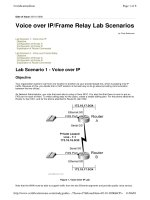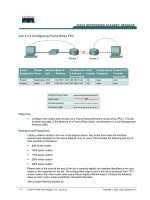Chapter 03 frame relay
Bạn đang xem bản rút gọn của tài liệu. Xem và tải ngay bản đầy đủ của tài liệu tại đây (1.36 MB, 54 trang )
Chapter 3: Frame Relay
CCNA Exploration 4.0
2
Objectives
•
Describe the fundamental concepts of Frame Relay technology in terms
of enterprise WAN services, including operation, implementation
requirements, maps, and Local Management Interface (LMI) operation.
•
Configure a basic Frame Relay permanent virtual circuit (PVC), including
configuring and troubleshooting Frame Relay on a router serial interface
and configuring a static Frame Relay map.
•
Describe advanced concepts of Frame Relay technology in terms of
enterprise WAN services, including subinterfaces, bandwidth, and flow
control.
•
Configure an advanced Frame Relay PVC, including solving reachability
issues, configuring subinterfaces, and verifying and troubleshooting a
Frame Relay configuration.
3
Basic Frame Relay Concepts
4
Introducing Frame Relay
•
Frame Relay: the most widely used WAN technology in the world
because of its price and flexibility.
•
Frame Relay reduces network costs by using less equipment, less
complexity, and an easier implementation.
•
Frame Relay provides greater bandwidth, reliability, and resiliency than
private or leased lines.
•
With increasing globalization and the growth of one-to-many branch
office topologies, Frame Relay offers simpler network architecture and
lower cost of ownership.
5
Introducing Frame Relay: Example
6
Introducing Frame Relay
•
Cost Effectiveness of Frame Relay
–
Customers only pay for the local loop, and for the bandwidth they
purchase from the network provider. Distance between nodes is not
important.
–
It shares bandwidth across a larger base of customers.
•
The Flexibility of Frame Relay
–
A virtual circuit provides considerable flexibility in network design.
–
In Frame Relay, the end of each connection has a number to identify
it called a Data Link Connection Identifier (DLCI).
7
The Frame Relay WAN
•
In the late 1970s and into the early 1990s, the WAN technology joining
the end sites was typically using the X.25 protocol. X.25 provided a very
reliable connection over unreliable cabling infrastructures.
•
WAN: three basic components, or groups of components, connecting
any two sites: DTE, DCE and the telephone company’s backbone
8
The Frame Relay WAN
•
Frame Relay has lower overhead than X.25 because it has fewer
capabilities.
•
The Frame Relay node simply drops packets without notification when it
detects errors.
•
Frame Relay handles volume and speed efficiently by combining the
necessary functions of the data link and network layers into one simple
protocol.
•
Frame Relay operates between an end-user device, such as a LAN
bridge or router, and a network.
–
It does not define the way the data is transmitted within
the service provider’s Frame Relay cloud.
–
Some networks use Frame Relay itself, but others use
digital circuit switching or ATM cell relay systems.
9
Frame Relay Operation
•
The connection between a DTE device and a DCE device consists of :
–
The physical component: defines the mechanical,
electrical, functional, and procedural specifications for
the connection between the devices.
–
The link layer component: defines the protocol that
establishes the connection between the DTE device, such
as a router, and the DCE device, such as a switch.
•
When carriers use Frame Relay to interconnect LANs, a router on each
LAN is the DTE.
•
The Frame Relay switch is a DCE device.
•
A serial connection, such as a T1/E1 leased line, connects the router to
the Frame Relay switch of the carrier at the nearest point-of-presence
(POP) for the carrier.
10
Frame Relay Operation
11
Virtual Circuits
•
The connection through a Frame Relay network between two DTEs is
called a virtual circuit (VC).
•
The circuits are virtual because there is no direct electrical connection
from end to end.
•
SVCs, switched virtual circuits, are established dynamically by sending
signaling messages to the network (CALL SETUP, DATA TRANSFER,
IDLE, CALL TERMINATION).
•
PVCs, permanent virtual circuits, are preconfigured by the carrier, and
after they are set up, only operate in DATA TRANSFER and IDLE
modes. Note that some publications refer to PVCs as private VCs.
12
Virtual Circuits
•
VCs provide a bidirectional
communication path from one
device to another.
•
VCs are identified by DLCIs
which typically are
assigned by the Frame
Relay service provider.
•
Frame Relay DLCIs have local significance, which means that the values
themselves are not unique in the Frame Relay WAN.
•
A DLCI has no significance beyond the single link. Two devices
connected by a VC may use a different DLCI value to refer to the same
connection.
13
Virtual Circuits
102
432
119
579
201
1414
•
The FRAD or router connected to the Frame Relay network may
have multiple virtual circuits connecting it to various end points.
•
This makes it a very cost-effective replacement for a full mesh of
access lines.
•
Each end point needs only a single access line and interface.
•
More savings arise as the capacity of the access line is based
on the average bandwidth requirement of the virtual circuits,
rather than on the maximum bandwidth requirement.
Multiple VCs
15
Frame Relay Encapsulation Process
•
Frame Relay takes data packets from a network layer protocol, such as
IP or IPX, encapsulates them as the data portion of a Frame Relay
frame, and then passes the frame to the physical layer for delivery on
the wire.
16
Frame Relay Encapsulation
•
The header and trailer are defined by the Link Access Procedure for
Frame Relay (LAPF) Bearer Services specification, ITU Q.922-A.
17
Frame Relay Encapsulation
•
DLCI - The 10-bit DLCI is the essence of the Frame Relay header. This
value represents the virtual connection between the DTE device and the
switch. Each virtual connection that is multiplexed onto the physical
channel is represented by a unique DLCI.
•
Extended Address (EA) - If the value of the EA field is 1, the current
byte is determined to be the last DLCI octet.
•
C/R - The bit that follows the most significant DLCI byte in the Address
field. The C/R bit is not currently defined.
•
Congestion Control - Contains 3 bits that control the Frame Relay
congestion-notification mechanisms. The FECN, BECN, and DE bits are
the last three bits in the Address field.
18
Frame Relay Topologies
•
A topology is the map or visual layout of the Frame Relay network.
•
Complete topologies for design, implementation, operation, and
maintenance include overview maps, logical connection maps, functional
maps, and address maps showing the detailed equipment and channel
links.
•
Cost-effective Frame Relay networks link dozens and even hundreds of
sites.
•
Every network or network segment can be viewed as being one of three
topology types: star, full mesh, or partial mesh.
19
Frame Relay Topologies
•
Star Topology (Hub and Spoke)
–
simplest WAN topology
–
connections to each of the five remote sites act as spokes
–
the location of the hub is usually chosen by the lowest
leased-line cost
20
Frame Relay Topologies
•
Full Mesh Topology
–
Connects every site to every other site
•
Partial Mesh Topology
–
There are more interconnections than required for a star
arrangement, but not as many as for a full mesh
21
Frame Relay Address Mapping
•
Before a Cisco router is able to transmit data over Frame Relay, it needs
to know which local DLCI maps to the Layer 3 address of the remote
destination.
•
This address-to-DLCI mapping can be accomplished either by static or
dynamic mapping.
Inverse ARP
•
The Inverse Address Resolution Protocol (ARP) obtains Layer 3
addresses of other stations from Layer 2 addresses, such as the DLCI in
Frame Relay networks.
Dynamic Mapping
•
Dynamic address mapping relies on Inverse ARP to resolve a next hop
network protocol address to a local DLCI value.
22
Frame Relay Address Mapping
Static Mapping
•
Administrator uses this command:
frame-relay map protocol protocol-address dlci [broadcast] [ietf] [cisco].
23
Frame Relay Address Mapping
24
Local Management Interface (LMI)
•
The LMI is a keepalive mechanism that provides status information
about Frame Relay connections between the router (DTE) and the
Frame Relay switch (DCE)
•
The LMI is a definition of the messages used between the DTE (R1) and
the DCE (the Frame Relay switch owned by the service provider)
•
LMI Extensions
–
VC status messages: Provide information about PVC integrity by
communicating and synchronizing between devices
–
Multicasting: Allows a sender to transmit a single frame that is
delivered to multiple recipients.
–
Global addressing: Gives connection identifiers global rather than
local significance, allowing them to be used to identify a specific
interface to the Frame Relay network.
–
Simple flow control: Provides for an XON/XOFF flow control
mechanism that applies to the entire Frame Relay interface
25
Local Management Interface (LMI)
•
The 10-bit DLCI field supports 1,024 VC identifiers
•
LMI messages are exchanged between the DTE and DCE
using these reserved DLCIs.
VC Identifiers VC Types
0 LMI (ANSI, ITU)
1…15 Reserved for future use
992 … 1007 CLLM
1008 … 1022 Reserved for future use (ANSI, ITU)
1019, 1020 Multicasting (Cisco)
1023 LMI (Cisco)









